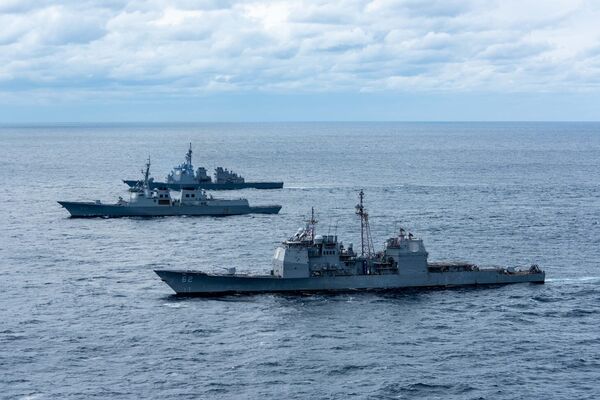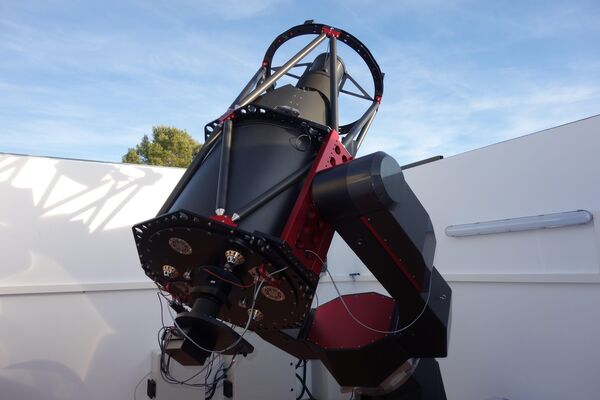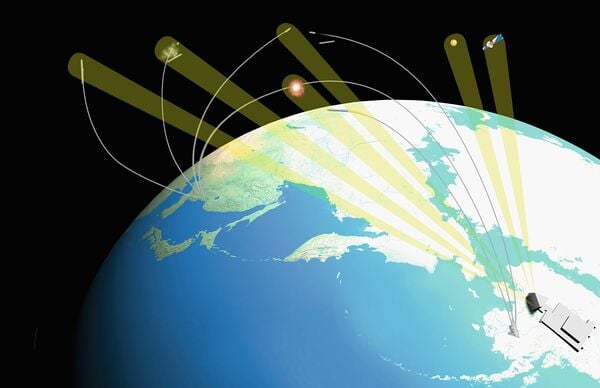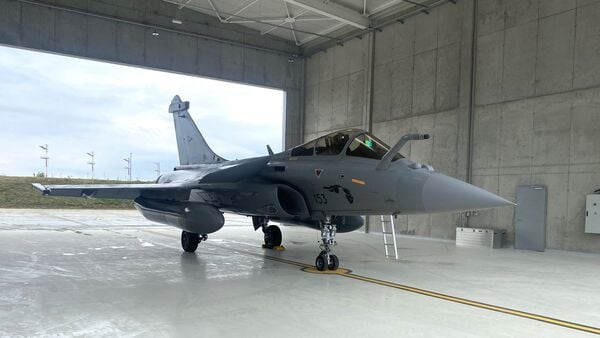- About
- Intara
- Capabilities
- Advisory
- Resources
- News
- Store
Japan, South Korean, US navies conduct ballistic missile exercise after Pyongyang's show of force
07 October 2022
by Ridzwan Rahmat


The Ticonderoga-class cruiser USS Chancellorsville (foreground) along with the JMSDF destroyer JS Chokai (background) and Republic of Korea Navy guided-missile destroyer ROKS Sejong Daewang conduct a trilateral ballistic missile defence exercise in the Sea of Japan on 6 October. (US Navy)
The navies of Japan, South Korea, and the US have conducted a joint ballistic missile defence (BMD) exercise in response to Pyongyang's recent show of force.
The drills were conducted in the Sea of Japan (East Sea) on 6 October, according to a statement released by the US Pacific Fleet on the same day. It was done as a response to North Korea's launch of an intermediate-range ballistic missile (IRBM) that flew over Japan on 4 October, said the service.
“This exercise enhances the interoperability of our collective forces and demonstrates the strength of the trilateral relationship with our Japan and Republic of Korea allies, which is forward-leaning, reflective of our shared values, and resolute against those who challenge regional stability,” the service added in its statement.
UK explores new radar and IR tech to enhance SDA
26 April 2024
by Olivia Savage


UK company Spaceflux has been contracted to develop and operate a ground-based SDA sensor as part of Project Nyx Alpha to monitor objects in GEO for UK Space Command. (Spaceflux)
The UK's Defence Science and Technology Laboratory (Dstl) is conducting three technology demonstrator programmes to explore the utility of novel space domain awareness (SDA) technologies.
The first programme is exploring the development of a Deep Space Radar (DSR) designed to monitor and protect geostationary orbit (GEO) assets such as the Skynet satellite communications system, William Feline, senior principal advisor for SDA at the UK Ministry of Defence (MoD), said at the Military Space Situational Awareness Conference 2024, held in London from 22 to 24 April.
The purpose of the programme is also to assess whether the UK needs its own DSR capability or whether it can rely on or complement the Deep Space Advanced Radar Capability (DARC) currently being developed alongside Australia and the US, Emma Kerr, senior principal engineer for SDA at Dstl told Janes .
A monostatic or biostatic system is being considered as well as whether a new or existing system is required, Feline said.
MDA, Lockheed Martin seek ‘final transition' of LRDR
26 April 2024
by Carlo Munoz


An artist's concept of how Lockheed Martin's LRDR would detect ballistic missile launches from Asia. The radar completed preliminary design review in March and will go through critical design review in September 2027. (Lockheed Martin)
The Pentagon's Missile Defense Agency (MDA) and its industry counterparts at Lockheed Martin are preparing for the ‘final transition' of the long-awaited Long Range Discrimination Radar (LRDR) to the US armed forces in the Indo-Pacific region.
LRDR programme officials officially transitioned control of the S-band missile defence radar to the MDA on 23 April, according to a company statement. The handover of the system, currently stationed at Clear Space Force Station in Alaska, will allow agency officials to finalise the Operational Capability Baseline (OCB) milestone, which is the final stage before the LRDR is handed over to US Space Force (USSF) units. “Prior to this transition, the system has started space domain awareness data collects” for USSF units, the 23 April statement said.
Rafale enters Croatian service
26 April 2024
by Gareth Jennings


One of the first six Rafales to be delivered to Croatia. Deliveries of all 12 aircraft will be complete by mid-2025. (Dassault)
Croatia has inducted into service the Dassault Rafale combat aircraft it recently received from France.
The manufacturer announced the milestone on 25 April, saying the first six of 12 Rafales had been formally received into service by the Croatian Air Force (Hrvatsko ratno zrakoplovstvo i protuzračna obrana: HRZ i PZO).
Having been handed over to the Croatian Ministry of Defence (MoD) at the French Air and Space Force (Armée de l'Air et de l'Espace: AAE) base at Mont-de-Marsan in France in 2023, these initial aircraft were received into the 91 operational base near Zagreb in a ceremony that was attended by Croation Prime Minister Andrej Plenković and Minister of Defence Ivan Anušić.
With the Rafale to be operated by 191 Squadron, the first of the follow-on batch of six aircraft will arrive in Croatia by the end of 2024 to complete the unit by mid-2025.
For more information on the Croatian Air Force, please seeCroatia – Air Force .
The navies of Japan, South Korea, and the US have conducted a joint ballistic missile defence (BMD) ...
Latest Podcasts
Iran Israel analysis
In this podcast Janes analysts discuss the Iranian attacks on Israel on the 14 April. They highlight the military systems used by Iran and the performance and impact of these on Israel. They also discuss the implications of this attack goi...
Listen nowJanes Case Studies
Using Janes Intara to build a common intelligence picture: Russian build up on the Ukrainian border
View Case StudyNews Categories
 Sea Details
Sea Details